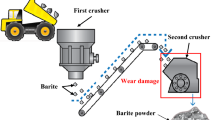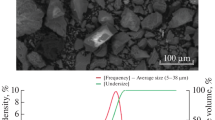Abstract
Incorporation of roller presses in the grinding circuits of cement manufacturing plants was borne out of the dire need to reduce the power consumed by ball mills in its finish grinding process. This study evaluated the wear phenomena of a roller press installed in a cement plant. Two improvised wear measuring devices (IWMDs) were constructed on a laboratory scale with chevron lines created on each of the rollers. One of the IWMDs had 1.00% chromium and 0.20% molybdenum exhibiting the exact properties of the existing roller press. The other IWMD had 1.10% chromium and 0.22% molybdenum. The IWMDs were subjected to grinding operation with the same raw material of sized media fed at 0.2 tonnes/h for a continuous grinding period of about 6 h per day. Wear measurements were taken on the lines monthly for trending and up till the end of 733 h test running. The chevron lines on the IWMD with Xuper 646 XHD chipped off after 17.5 h of operation, while that with chevron lines made with AbraTec 6710 XHD was in operation for a cumulative period of 733 h within 7 months. Results on the AbraTec 6710 XHD model showed a maximum of 0.04 mm/tonne average wear within a span of 7 months compared to the chipped-off lines and an average wear rate of 1.75 mm/tonne on the Xuper 646 XHD IWMD having characteristics of the existing equipment. The AbraTec 6710 XHD IWMD indicated its suitability for clinker–limestone grinding roller press compared with Xuper 646 XHD.












Similar content being viewed by others
References
E. Mastorakos, A. Massias, C.D. Tsakiroglou, D.A. Goussis, V.N. Burganos, A.C. Payatakes, CFD Predictions for Cement Kilns Including Flame Modelling, Heat Transfer and Clinker Chemistry, Institute of Chemical Engineering and High Temperature Chemical Processes, Foundation for Research and Technology (1999), p. 1
E. Worrell, C. Galitsky, Energy efficiency improvement and cost saving opportunities for cement making, Energy Star, Ernest Orlando Lawrence Berkeley National Laboratory (2008), pp. 4–7
The Energy Conservation Center (ECC), Cement Industry. Output of a seminar on energy conservation in Cement Industry, (1994), p. 3
A.S. Gomes, Energy saving and environmental impact in the cement industry, in Energy efficiency in the cement industry, ed. by J. Sirchis (Elsevier Applied Science, London, 1990), pp. 23–26
E. Worrell, L. Price, N. Martin, C. Hendriks, L.O. Meida, Carbon dioxide emissions from the global cement industry. Ann. Rev. Energy Environ. 26(1), 303–329 (2001)
Lafarge Africa Plc, Roller Press wear specific measurements, Ewekoro II Methods Department (2014), pp. 1–10
P.A. Alsop, Cement plant operations handbook for dry process plants (Cemex S.A de C.V, San Pedro Garza García, 2003), pp. 1–4
M. Suliga, The influence of the high drawing speed on mechanical-technological properties of high carbon steel wires. Arch. Metall. Mater. 56(3), 823–828 (2011)
M. Suliga, R. Kruzel, The mechanical properties of high carbon steel wires drawn in conventional and hydrodynamic dies. Metalurgija 52(1), 43–46 (2013)
www.substech.com/abrasive. Accessed 2017
A. Milenin, Software Drawing 2D—general tool for analysis of technological processes of multi-pass drawing. Metall. Metall. News 2, 100–103 (2005)
L. Efsing, S. Olsson, Wear testing of high-alloy carbon steel used in mining tools (Royal Institute of Technology Stockholm, Sweden, 2013), pp. 1–6
Goggle Patents, Edge wear components for Roller Presses. Publication Number EP2771119 A1 (2014), p. 1
A.A. Hani, S.H. Khairia, M.M. Ethar, Effect of loads, sliding speeds and times on the wear rate for different materials. Am. J. Sci. Ind. Res. 2, 99–106 (2011)
G.R. Kibouka, D. Nganga-Kouya, J. Kenné, V. Polotski, Maintenance and setup planning in manufacturing systems under uncertainties. J.Qual. Maint. Eng. 24(2), 170–184 (2018). https://doi.org/10.1108/JQME-11-2016-0069
M. Kumar, R.C. Gupta, Abrasive wear characteristics of carbon and low alloy steels for better performance of farm implements. J. Mater. Sci. Technol. 11, 92 (2002)
R. Manna, Heat Treatment (Institute of Technology, Babaras Hindu University, Department of Metallurgical Engineering, Varanasi, 2005), pp. 3–8
D.A. Fadare, T.G. Fadara, O.Y. Akanbi, Effect of heat treatment on mechanical properties and microstructure of NST 37-2 steel. J. Miner. Mater. Charact. Eng. 10(3), 299–308 (2011)
V. Gamit, Lecture notes on principles of tribology (Mech. Eng. Dep., IISc, 2008), pp. 5–12
S.K. Lee, D.C. Ko, B.M. Kim, Pass schedule of wire drawing process to prevent delamination for high strength steel cord wire. Mater. Des. 30(8), 2919–2927 (2009)
Acknowledgments
The authors are grateful to the management and staff of Lafarge Africa Plc. for the permission given to make use of their facilities to execute this project.
Author information
Authors and Affiliations
Corresponding author
Ethics declarations
Conflict of interest
The authors declare that they have no conflict of interest.
Additional information
Publisher's Note
Springer Nature remains neutral with regard to jurisdictional claims in published maps and institutional affiliations.
Rights and permissions
About this article
Cite this article
Adetunji, O.R., Onawoga, D.T., Adegbesan, O.O. et al. Modification of Steel Roller Composition to Curb Excessive Wear. J Fail. Anal. and Preven. 19, 1655–1665 (2019). https://doi.org/10.1007/s11668-019-00762-3
Received:
Revised:
Published:
Issue Date:
DOI: https://doi.org/10.1007/s11668-019-00762-3




